Abstract
The existence of any security and crime issues will involve the existence of a police station. The presence of a police station in any particular area can bring a sense of security and also protected feelings for a person. Indirectly, a police station is also considered as capable of reflecting the level of concern and sensitivity of the government and authorities to ensure the safety of every individual, community, and nation. This study aims to identify the architectural design of Malaysian police stations are following the current standard operating procedures (SOP) and the requirements of the Royal Malaysia Police (RMP / Polis Diraja Malaysia - PDRM). A police station is the primary logistics for the operation of the RMP in addressing crime and security issues. The study involved a mixed methodology that started with a thorough review of journal articles, inspecting the guidelines and technical reports, distributing questionnaires, and conducting semi-structured interviews and field observations (case study). Nine (9) police stations in three (3) Malaysian states with high crime index, namely Johor, Selangor, and Pulau Pinang, were chosen as the case study subjects. This study found that the design of a police station (in Malaysia) must be aware and understand the needs of the end-users (i.e., RMP) so that the police station built can elevate the efficiency of the RMP security services.
Keywords: Police station, security building design, standard operating procedures (SOP), Royal Malaysia Police (RMP)
Introduction
In 2013, the Federal Government of Malaysia had allocated an average of RM400 million annually for the construction of several numbers of Royal Malaysia Police (RMP) police stations, aiming to provide effective security assurance services and to preserve the peace and order of the public from time to time (KDN, 2015). Observing the overall physical conditions of many existing police stations that were built even before the Independence of Malaya in 1957, this study aims to identify and understand the concept of the essential needs in the design of a police station, while at the same time is to assess whether existing police stations are still relevant or not to serve. The relevancy of a police station is based on its ability to carry out duties as a safety element based on the needs and wants and challenges of the RMP team (Othman, Omar, Jabar, & Idris, 2016).
At the time this study been conducted, the approach made by the Malaysian Ministry of Home Affairs ( - KDN) and the RMP to 'erase' the worn-out physicality of many RMP's police stations buildings were to paint the affected structures to again look beautiful and new (Bernama, 2014). Although the old police stations now look new, however, the fact is that that particular police station's service capability is still limited to its previous original design, circulation, and interior spaces arrangement. Many of these buildings are no longer suitable for the current requirements, needs, and the SOP of RMP (PDRM, 2009). To fall under the category of a security building, a police station is subject to a variety of requirements, needs, and SOPs; it is, therefore, is subject to specific requirements of care (Irwan, 2014). Police station buildings must always be of good quality, while at the same time should look pleasing and confident in the eyes of the public (Morgan & Coughlan, 2018). A police station must also be able to inject the positive spirit into its team members and staff to be committed, high integrity, productive, and effective (Sohn, 2016).
Recognizing this issue, in 2017, RMP Management Director, Dato' Sri Zulkifli Abdullah, suggested that 22 police stations in Kuala Lumpur to be upgraded into a modern police station alongside the effort to establish RMP a world-class security organization (Bernama, 2017). A modern police station is interpreted as a police station that meets the needs of physical design and logistics, regarding current guidelines and needs of end-users, in line with the need to improve the quality of monitoring and prevention of universal crime (Gatchell & Reeves, 2013).
Therefore, continuous research to study the level of efficiency of the design of police stations in Malaysia should continue, to ensure that all police stations in Malaysia continue to remain relevant to the needs of the RMP (in implementing their SOP) at each police station (MOHA, 2010). Hence, having the facilities (i.e., the police stations) that remain relevant, therefore, the RMP can provide the best security services to the community (Kalayci & Bilir, 2016).
Definition of a security building
A security building is defined as a building that provides a working space to performs elements and activities of enforcement and crime prevention in accordance to established operating procedures and guidelines for all assigned personnel.
The major facility components (zone) in Malaysian police stations
A standard, current Malaysian police station has three (3) major facility components (zone), namely (i) the main facilities, (ii) ancillary facilities - supporting, operating, and storage components, and (iii) operation facilities such as marching ground, transit quarters, and security fencing as shown in Figure 1.
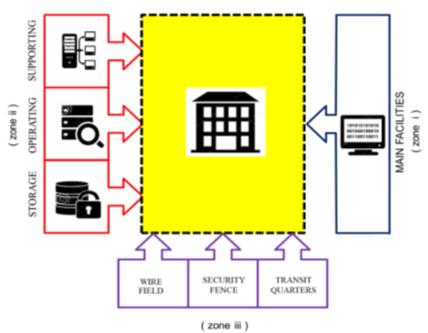
These three major facilities were investigated, and assessment is conducted to ensure improved design to suit the requirements, needs, and latest SOP of the RMP (will be discussed in detail in the Findings section).
Main facilities
There are altogether 16 sub-components within the main facilities zone of a police station consisting of one-stop centre service counter, CCTV room, the 'Black Maria' vehicle parking, the detainee or accused ( - OKT) body-check room, OKT registration and personal storage room, identifying and observation rooms, interrogation room, OKT meeting room, armoury (firearms depot), lockups (male, and female), lockups controller room, and other office spaces consist of Administrative, Armament, Transportation, Information Technology (IT), Communications, Outlets Equipment, and General Procurement (PDRM, 2009). Of these 16 sub-components (of the main facilities), they are five (5) most important sub-components that are compulsory to have for a security building to be gazetted a police station; they are the (i) one-stop-service counter (front desk), (ii) office spaces, (iii) CCTV room, (iv) armoury, and (v) the lockups. These five (5) most important sub-components must be interconnected in terms of their locations, circulation, and the SOP to ensure the overall safety of this security building. Usually, the front desk counter and the administration office are located at the front part of the building, while the CCTV room, armoury, and lockups will be at the rear part of the police station.
Ancillary facilities
The ancillary facilities components are consisting of the guard post, pound traffic vehicle area, department vehicles garage, visitors parking, multipurpose hall, a surau (prayer room), multipurpose/playing field, and landscaping. These sub-components support the main facilities in terms of better security building's everyday operations and tighter security (Degnegaard, Degnegaard, & Coughlan, 2015). One way these sub-components can act as the first layer of the building's security belt is the main entrance with a guard post and equipped with high-quality security fencing. While, the second layer (of security belt) can be the visitors parking, the multipurpose/playing field, the landscaping, the pound vehicles yard, and department vehicles garage (which cannot be entered by unauthorized persons).
Supporting facilities
The supporting facilities sub-components are consisting of (i) marching square, (ii) security fences, and (iii) the transit quarters. Security fences are used to control and protect the boundaries of the police station, including transit quarters, from trespassers or subversive parties.
Operation and activities in a police station
After all the factors and justifications to establish one police station by referring to the existing guidelines are done; the final design of a police station must also need to refer to the needs of the reality of the daily duty routines of the RMP personnel at work (PTKPN, 2016). Below are some of the daily duty routines at the police station.
Accepting reports and complaints
A complainant goes to the police station to lodge a report or complaint at the one-stop centre service counter. Subsequently, the RMP personnel on duty will accept and process the complaint form before finalizing the report for further action by an investigation officer.
Arresting criminals
Once arrested, the detainee (OKT) will be taken to the police station. At the station, a physical examination will take place in the examination room. Physical examination is conducted to avoid the OKT from bringing into the lockups prohibited or dangerous items like drugs or any objects as a mean of weapons.
OKT interrogation
After an OKT recognition (by witness) activity is done, interrogation (investigation) activity is to be held in the interrogation room, which is a closed, safe, soundproofed area, and located near to the lockups (see Figures 2 and 3) so to save time, east transporting (Tang, Wang, Han, & Lian, 2016), and protect the identity of the OKT. OKT can sometimes act beyond the control and endanger the safety of the lockups guard.
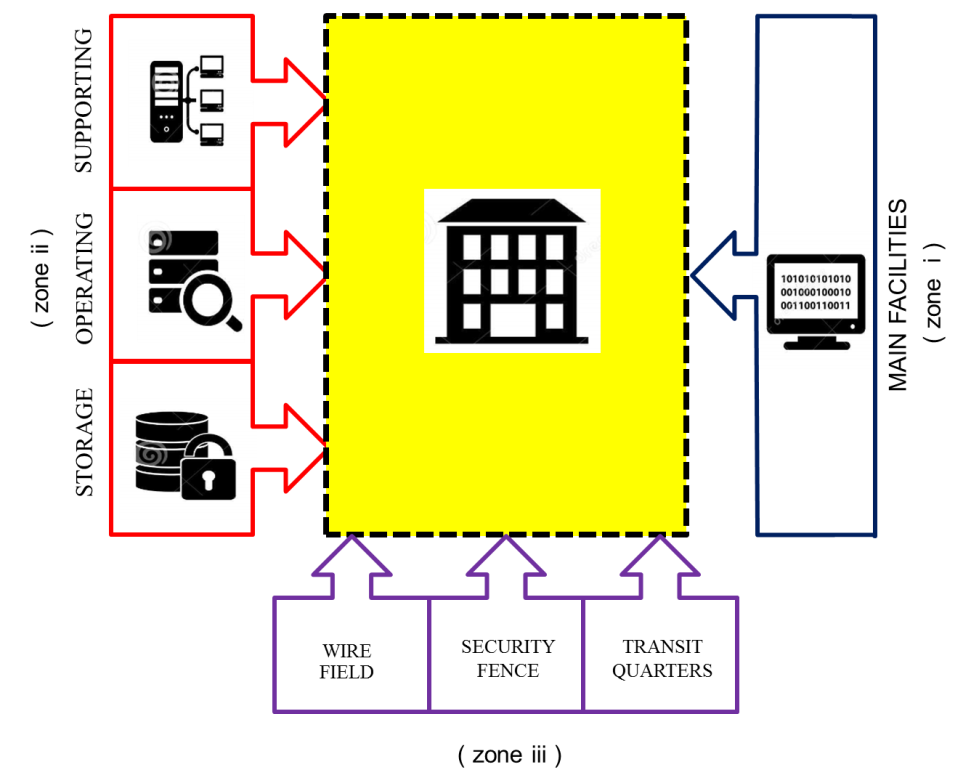
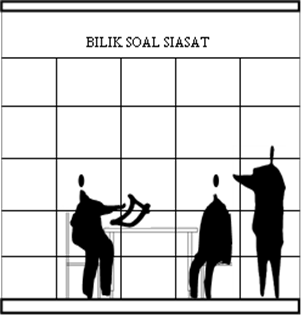
Armoury
A police officer carries a firearm during his/her routine duties. Firearms are kept in the armoury (Figure 4) located inside the station building. Firearms handling activities involved the issuance and the returning of the weapons. After each completed routine duties, all personnel are to empty their weapon magazines before the weapon be returned to the weaponry issuance/returning counter together with unused bullets (PDRM, 2009).
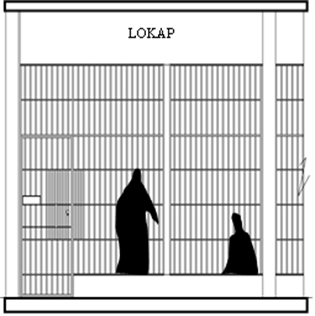
The lockups
The OKT lockups (detention facility) provided at the police station (Figure 5) are subject to the design guidelines outlined by the (PDRM, 2016), (JPM, 2017) and (JPM, 2000) documents. Ample space is allocated within lockups for OKT performing some exercises but under close monitoring of the lockup’s guards (Figure 6).
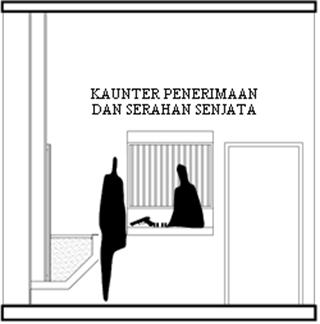
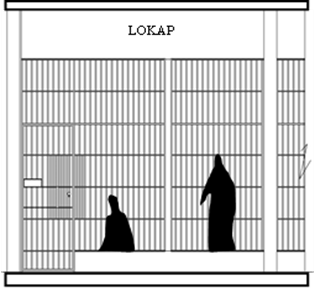
Some criteria need to be observed when designing a lockup. It is crucial to avoid legal disputes, especially in terms of managing the emotions of the OKT being locked. Based on studies conducted by the Human Rights Commission Malaysia (SUHAKAM), OKT injuring self and or other OKT, suicide and attempting suicide were reported as a result of unstable emotions during detention (SUHAKAM, 2016). To prevent undesirable issues, the standards and design specifications for a lockup must be carefully addressed. The safety of lockup guards on duty should also be taken seriously (JPM, 2000). The design of a lockup must eliminate blind spots to reduce the risk of security threats by the OKT on the lockup’s guards (PDRM, 2009).
Note: To note, there is a limitation in this study that must be acknowledged; there is some information obtained from this study treated as CONFIDENTIAL and SECRET under the provisions of the Official Secrets Act, 1972 (Akta Rahsia Rasmi) (PDRM, 2012). Information such as the actual photos recorded inside the studied police stations cannot be disclosed to general readers, to prevent issues of leakage of information for National Security purposes (KPKK, 2006).
Problem Statement
There is a considerable gap in terms of the need for those earlier built police stations compared to the current RMP police station's requirements, needs, and SOP (PDRM, 2017 & UPE, 2015). The suitability of the design functions of previous, older police stations, should be assessed in tandem with the current needs of increasingly skilled security services (Hunnur, Bagali, & Sudarshan, 2014). The top management of the RMP needs to be aware of the current security environment despite having to maintain the older or existing building structures and parameters. The method of upgrading and renovating the older buildings is just a short-term strategy just to meeting the needs of serving the community (Bruggen, 2013). While, several cases of police stations intrusions, attacks, and other concerning security issues in Malaysia, is an explanation for the need of improvement to be done (Harian, 2017). Hence, the relevancy of existing police stations to meet the latest security service expectations (whether they are still relevant to the current security building needs) is to be correctly studied (Yusoff, Yusof, & Talib, 2013).
Research Questions
The primary purpose of this study is to evaluate the best method to improve the current Malaysian police station design to be operated at the most efficient level in line with the requirements, needs, and the SOP of the current operations of RMP. There are two (2) research questions raised in this study, and they are as follows:
- Is the application of physical security elements onto Malaysian police station design follows the current requirements, needs, and SOP of the RMP?
- What is the best design calibration to integrate the RMP's (as the end-users) design requirements, with the existing design of Malaysian police stations?
Purpose of the Study
Purposely, this study is designed to identify the level of efficiency of (selected) Malaysian police stations following the current requirements, needs, and SOP of the RMP. Results from this study are expected to:
- Assisting the security building design team (at the Malaysian Public Works Department (Jabatan Kerja Raya - JKR, and their consultants) to have a better understanding of how a police station building operated;
- Providing security building design awareness to clients (KDN), end-users (RMP), and the project implementers (JKR);
- Improves the physical security design aspects of a police station to address security threats.
Research Methods
This study implemented a mixed-methodology strategy involving the use of questionnaires, semi-structured interviews, and on-field observation (case studies) (Groat & Wang, 2002). These strategies were used to obtain honest feedback from respondents, and to record the real picture through the assessment of the efficiency of the design of the existing RMP police stations. A total of 270 questionnaire forms distributed, with an average of 30 respondents per police station responded. 250 (92.6%) survey forms answered and returned, and this reflected the positive cooperation shown by the RMP staff members of the selected police stations involved in the survey.
The semi-structured interview method was selected to obtain direct information and views from the respondents in the effort to identify issues or problems faced by the police stations involved. Respondents interviewed are only involving RMP officers and other non-commissioned staff with a background in the RMP's buildings, assets, and facilities management; therefore, to seek more accurate and comprehensive information.
The on-site observation (case study) involved visits to all parts of the building (interior, exterior, as well as outer perimeters) of each police station with the documentation of information through sketching, photo images, and verbal recording.
Findings
The information obtained from the observation work and the 250 respondents' feedback assisted in providing some guidance to the designers (architects) and the RMP generally in the pursuit of more efficient police station design based on the requirements, needs, and current SOP of the RMP. These findings should not necessarily impede the creativity of architects in producing excellent work of architecture; instead, it should provide an added value element in finding the most appropriate design solution for developing an efficient Malaysian police station design in the future.
A summary of the findings obtained from this research activities conducted will include the discussion on the recruitment and RMP personnel provision issues, designing discrepancies, and the improvement efforts needed in a police station in Malaysia.
Insufficient work force
One of the most important notes to be seriously addressed in the issue of the ineffective police station is the insufficient number of police personnel assigned at one station. The issue is becoming severe when the department cannot fulfill the number of personnel needed on time. To address this issue, the management of that affected police station must continuously be applying for new posts from the top management of the RMP. Exhaustion and overworked could lower the morale of operating personnel, therefore compromising the public's safety and security.
Police station design discrepancies
The existence of design discrepancies in the researched police stations is due to:
- the design of the police station was not following the specifications of the requirement, needs, and the current SOP of RMP. This issue started earlier even sometimes at the directive of the RMP's top management before the stations were designed and later built;
- The weakness in the overall design of the problematic police station was also due to the ad-hoc or unplanned renovation activities (either the interior or the exterior) according to the urgent needs of the existing police station operations;
- an increase in the current crime index could have resulted from that researched police stations were being forced to operate exceeding their maximum capacity, and even with incomplete and inadequate security building facilities; and
- The financial constraints and difficulties in obtaining a temporary transitional place intended to allow some space for the upgrading work of the researched police stations to take place. The nature of the work of a police station that operates 24-hours is complicated to avoid and cannot be interrupted.
However, the discrepancies are avoidable, therefore it must be resolved quickly, especially to avoid legal disputes over the operation of the police stations, while at the same time enabling the design of the police stations to remain relevant in the future, and to operate efficiently at any time for a more extended period.
Improvement and standardization of Malaysia police station design
The weaknesses and disadvantages of the existing researched police stations designs can probably be addressed through the application of these specific methods:
- To upgrade technical specifications;
The majority of these police station's physical defense systems were found to be vulnerable to subversive movements that could be threatening the safety of the RMP personnel themselves. The station's physical defense systems need to be upgraded from time to time. For instance, the existing specifications for the security fences used is the chain-link fence type must be changed and upgraded to a sturdier anti-climb fence type. This type of fencing could indirectly be slowing down climbing; therefore, it can reduce any possible attacks onto the premises.
Findings also show that there is a lack of uniformity for the technical specifications of important spaces such as the lockup, interrogation room, detention area, and even the condition of the lockups. This matter indirectly provides space for legal disputes and gives the public a negative perception on RMP.
- To design based on the crime index;
There is also a need for improvements in the design of the existing police station facilities based on the increasing number of crime indices. A formulated strategy is needed to ensure that the ratio of RMP personnel is at least equal or exceed the current crime index in order to maintain the effectiveness of the design of the station. However, please note that the increasing number of RMP personnel in one police station, imperatively, that facility will need to be adequately provided with complete sub-components to ensure the welfare of the RMP personnel.
- To correctly select a site
Choosing the location for a police station involves consideration of factors such as the size of the site (should be within five to 10 acres according to the UPE guidelines), the status of the land, availability of infrastructure (access from the major road network, clean water, and electricity supplies). It will have a positive impact on the overall design of a police station, such as saving on the overall cost of building. A poorly selected site, such as not having enough building area, can cause a police station not to function correctly. The imperfection of a site will also result in the provision of the facility components (zones) not being complied with the RMP requirements, needs, and SOP.
Conclusion
A good police station design should start by identifying and understanding the precisely necessary elements, i.e., the requirements, the needs, and the current SOP of the RMP, together with the components of the spaces, the types of building materials needed, as well as the essential equipment that should be used in the operation of a police station. All these fundamentals will influence the final design of a police station.
The design of a police station that not complying with the requirement, needs, and current SOP of the RMP will harm the level of efficiency of the RMP personnel on duty. This condition will also provide a space for debate and opportunity for legal disputes (by interested individuals) for activities taking place in the police station; therefore, it will impact the image and integrity of RMP negatively. To avoid this negativity, at the initial design stage, a police station design planning should be conducted thoroughly so to ensure that every major facility elements and sub-elements are sufficiently built in every RMP police station despite the difficulties in providing enough numbers of personnel. Figure 7 below shows the close relationship in between the three main elements (A = one-stop centralized service counter, C = administration office, and K = the lockup) and all the sub-components that need to be included in the design that could effectively form a ‘complete police station’. Below diagram is produced based on the feedback from the end-users (RMP personnel) and the guidelines available.
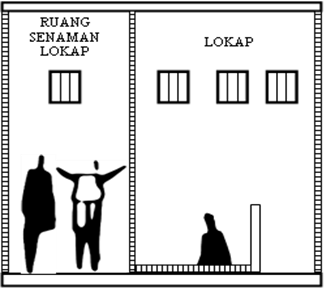
Concerning the upgrading and maintenance of all existing police stations, it is required to perform it regularly and from time to time, to ensure that the design of the police stations remains relevant and efficient to operate for extended period of time before needed for remodeling.
Finally, the value-added on the security building that complies with the requirements, needs, and the SOP of the RMP is crucially needed in future Malaysia police stations design. Hence, it is recommended that all future police stations must be designed (and all existing police station building is to be upgraded) not only according to the existing guidelines and requirements, but also alongside the feedback from the end-users (i.e., the RMP personnel).
Acknowledgments
First of all, we would like to thank the fund received from Universiti Sains Malaysia's Short-Term Grant No. 6313328; therefore, this paper can be published. Sincere heartfelt thanks to the Chief Secretary Ministry of Home Affairs Malaysia, the Inspector-General of Royal Malaysian Police, the Director-General of Public Works Malaysia, and also the Public Service Department of Malaysia on the Federal Training Prize 2018 awarded.
References
Bernama. (2014). KDN Kaji Naiktaraf Perjawatan Di Balai Polis Seluruh Negara: Berita Harian.
Bernama. (2017). PDRM Naiktaraf 22 Balai Polis Di KL. Retrieved from http://www.utusan.com.my/berita/nasional/pdrm-naik-taraf-22-balai-polis-di-kl-1.507048
Bruggen, B. V. (2013). Better Police Building.
Degnegaard, R., Degnegaard, S., & Coughlan, P. (2015). How to Design For Large-scale Multi-stakeholder Co-creation Initiatives: Reframing Crime Prevention Challenges With The Police In Denmark. Journal of Design, Business & Society, 1(1), 7-28.
Gatchell, W., & Reeves, I. (2013). Concept Design for A Combined Police Facility & Parking Garage Orchard Street Lot. Dover:NH.
Groat, L., & Wang, D. (2002). Architectural Research Methods. New York: John Wiley & Sons.
Hunnur, R. R., Bagali, M. M., & Sudarshan, S. (2014). Cause and effect of workplace stress among police personnel: an empirical study. International Journal of Management Research and Business Strategy, 3(1), 198-208.
Harian, B. (2017). Polis Ditembak Di Badan, Tetak Di Kepala Di Balai Polis Pinggiran Subang[The Police Are Shot In The Body, Put On The Head At Subang Subis Policy Center]. Berita: Harian.
Irwan, H. (2014). Hubungan Tekanan Kerja Dengan Prestasi Kerja Di Kalangan Personel Cawangan Trafik, Polis Diraja Malaysia (PDRM) Di Iskandar Malaysia, Johor. Universiti Teknologi Malaysia, UTM Johor.
JPM. (2000). Peraturan-peraturan Penjara 2000. Jabatan Penjara Malaysia.
JPM. (2017). Akta Penjara 1995 (Akta 537). Jabatan Penjara Malaysia.
Kalayci, P. D., & Bilir, M. B. (2016). Police Station Facades: Searching the Architectural Characteristics That Appreciate All. Gazi University Journal of Science, 29(1), 35-48.
KDN. (2015). Pelan Strategik Kementerian Dalam Negeri (2015-2020). Putrajaya: KDN.
KPKK. (2006). Arahan Keselamatan. Pejabat Ketua Pengarah Keselamatan Kerajaan Malaysia.
MOHA, S. (2010). Guidelines for Enhancing Building Security in Singapore. Singapore: Minister for Home Affairs, Singapore.
Morgan, A., & Coughlan, M. (2018). Police Use of CCTV On the Rail Network. Trends and Issues in Crime and Criminal Justice (561), 1.
Othman, Z., Omar, M. K., Jabar, F. A., & Idris, N. A. (2016). Memelihara Keselamatan Negara Malaysia: Peristiwa Lahad Datu, Sabah. GEOGRAFIA Malaysian Journal of Society and Space, 12(7), 147-159.
PDRM. (2009). Konsep Balai Polis. Polis Diraja Malaysia.
PDRM. (2012). Akta Polis 1967 [Akta 344]. Polis Diraja Malaysia.
PDRM. (2016). Kaedah-kaedah Lokap 1953. Polis Diraja Malaysia.
PDRM. (2017). Sejarah & Latar Belakang Balai Polis Skudai. Johor: Polis Diraja Malaysia.
PTKPN, P. (2016). Perintah Tetap Ketua Polis Negara.
Sohn, D.-W. (2016). Residential Crimes and Neighbourhood Built Environment: Assessing the Effectiveness of Crime Prevention Through Environmental Design (CPTED). Cities, 52, 86-93.
SUHAKAM. (2016). Kematian Dalam Tahanan Polis: Satu Kaji Selidik Mengenai Keadaan Lokap Dan Faktor-Faktor Penyumbang Kepada Kematian Suruhanjaya Hak Asasi Manusia.
Tang, Y., Wang, Y., Han, M., & Lian, Q. (2016). Adaptive Fuzzy Fractional-Order Sliding Mode Controller Design for Antilock Braking Systems. Journal of Dynamic Systems, Measurement, and Control,138(4), 041008.
UPE. (2015). Garis Panduan & Peraturan Bagi Perancangan Bangunan. Putrajaya: Unit Perancang Ekonomi (UPE).
Yusoff, M. N., Yusof, R., & Talib, A. (2013). Ke Arah Kelestarian Dalam Rekabentuk.
Copyright information

This work is licensed under a Creative Commons Attribution-NonCommercial-NoDerivatives 4.0 International License.
About this article
Publication Date
26 December 2017
Article Doi
eBook ISBN
978-1-80296-950-4
Publisher
Future Academy
Volume
2
Print ISBN (optional)
-
Edition Number
1st Edition
Pages
1-882
Subjects
Technology, smart cities, digital construction, industrial revolution 4.0, wellbeing & social resilience, economic resilience, environmental resilience
Cite this article as:
Zaharin, Z., Nordin*, J., & Shukri, S. M. (2017). Added Value To Security Building Design Case Study: Police Station In Malaysia. In P. A. J. Wahid, P. I. D. A. Aziz Abdul Samad, P. D. S. Sheikh Ahmad, & A. P. D. P. Pujinda (Eds.), Carving The Future Built Environment: Environmental, Economic And Social Resilience, vol 2. European Proceedings of Multidisciplinary Sciences (pp. 362-373). Future Academy. https://doi.org/10.15405/epms.2019.12.35
